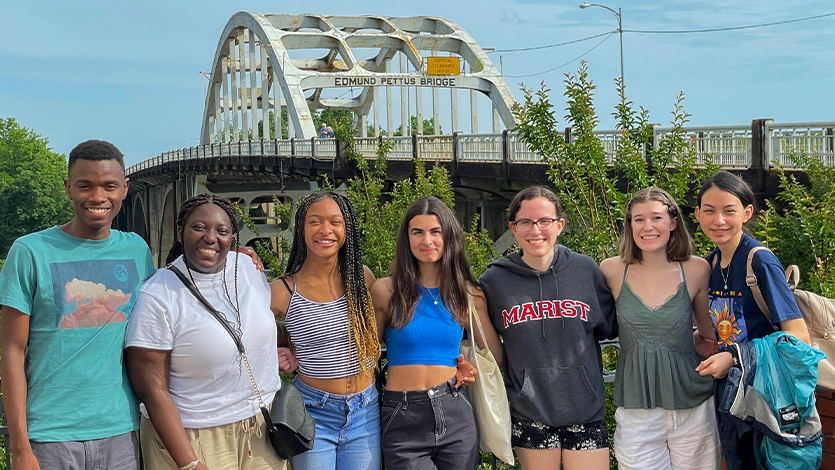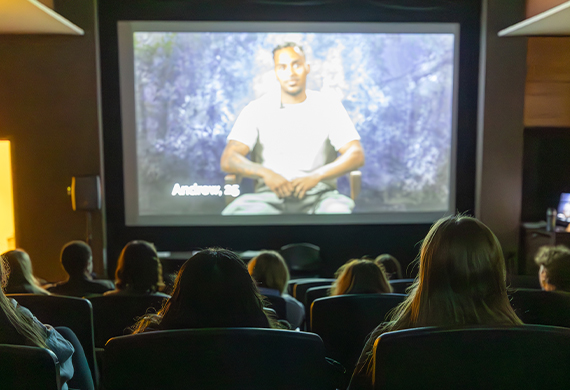Marist College Students Explore Civil Rights History in South

July 14, 2022 – Birmingham, Montgomery, Memphis, Jackson, all southern cities with a deep history, and an infamous past. Those were among the places explored by a group of Marist College students over a week-long span in May, part of an annual trip organized by Marist Professors of History Dr. Robyn Rosen and Dr. Steve Garabedian. The trip is designed as a way for Marist students to understand the central role race has played throughout American history.
The group of seven Marist students traveled throughout Alabama, Mississippi and Tennessee, exploring historic locations along the civil rights trail soon after the end of the spring semester. The trip is an annual one as part of a spring attachment course led by Dr. Rosen and Dr. Garabedian, called “The Struggle for Racial Justice in the South”.
“Getting out of the classroom and into the places where both ordinary and extraordinary people sacrificed to make our country more just continues to inspire me as a person, a citizen, and an educator,” said Dr. Rosen. “You can see the students putting the pieces together on the trip so that by the end of the week they have developed a deeper understanding of the struggle for racial justice, the way the story gets told, and the implications for today.”
Students visiting the Southern Poverty Law Center’s Civil Rights Memorial Center in Montgomery, Alabama.
“The student testimonies, this year, and in past years, demonstrate that this trip is valuable in terms of our nation's past, present, and future,” said Dr. Garabedian. “Our students enhance their historical understanding of race, inequality, and social struggle, and in so doing, they develop a sharper sense of present-day social issues. They don't just look backwards; they look forward. To use the language of our dynamic Mississippi tour guide, Jessie Jaynes-Diming, they return home with a "fire in the belly" to combat injustice in their own lived experiences.”
The students explored places such as the National Museum of Civil Rights at the Lorraine Motel in Memphis, where Martin Luther King, Jr. was assassinated, the Greyhound Station in Jackson, site where Freedom Riders arrived and were arrested, and the National Memorial for Peace and Justice in Montgomery, where thousands of African American victims of racial terror lynchings are remembered.
Left: Students at the Greyhound Station in Jackson, MS. Right: Students with Dr. Robyn Rosen (center) in front of the Lorraine Motel in Memphis, TN. Photos courtesy of Dr. Robyn Rosen.
The trip also included a visit to various sites in Mississippi related to the murder in 1955 of fourteen-year-old Emmett Till, the tragedy that sparked the modern civil rights movement. Students stood in the courthouse where Till's murderers were unjustly acquitted and learned about Till's life, death, and legacy at the Emmett Till Museum in Glendora and the Emmett Till Interpretive Center in Sumner.
“The trip felt like being in the past, present, and future all at once, meaning I was learning so much about the people that have worked, fought, and got killed for some of the rights I currently have as a black person in the United States,” said Kumba Nyang '23. “Trips like this are very important because it gives you an opportunity to be faced with the truths and realities of inequality that mainstream history tends to omit, forget, or lighten for the comfort of others.”
“You can read the same history in class over and over again, but being in the presence of buildings and cities where atrocities occurred is so much more valuable,” said Stephanie Sperounis '24. “It was chilling at times, but it made me more aware that this is our nation’s history. This trip was such a great experience, I definitely recommend anyone who is interested in these topics seriously consider going and learning more.”
“I took this spring attachment trip right after graduating and feel that it was the perfect culmination of my history education at Marist,” said Amanda Roberts, '22. “The visits to museums and historic sites allowed me to immerse myself in the history that I learned in Dr. Rosen’s African American History course and Dr. Garabedian’s Introduction to Public History course.”
“I think this trip has the power to shift perspectives and transform thought by encouraging critical thinking, participating in important conversations, and providing tangible experience to a history that is often dismissed or belittled,” said Caitlin Blencowe ’24. “I left the trip feeling incredibly empowered and would recommend it to anyone who is interested in activism and history.”
The students with artwork at the Stax Musuem of American Soul Music in Memphis, TN. Photo courtesy of Dr. Robyn Rosen
The students also visited the Mississippi Museum of Art, which hosted a special exhibit on the Great Migration, the movement of some six million African Americans from the South to the Northeast and Midwest from 1910-1970. They also visited the Stax Museum of American Soul Music in Memphis. Stax was a local recording studio that was dedicated to racial integration and launched the careers of people like Isaac Hayes, the Staple Singers, and Otis Redding.
This trip was among several faculty-led short-term attachment programs made available for Marist students in 2022. Based within Marist’s School of Liberal Arts, the History program offers both a major and a minor, and students can complete a public history concentration as part of their major. Marist students can also combine their history major with a Master’s Degree in Teaching in our five-year BA/MAT program.



